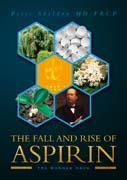Alan Dronsfield reviews this guide to aspirin
The fall and rise of aspirin - the wonder drug
Peter Sheldon
Studley: Brewin Books 2007 | Pp286 | £12.95 | ISBN 978-1-858-584-034

The author of this book is a doctor of medicine and this shows in his approach. Thus we have some 130 pages on assorted fevers and herbals and only in the latter part of this section do we touch on the willow bark which contains the salicylic acid derivative that was sometimes used as a pain reliever/fever reducer in the pre-aspirin era.
The 'chemical' section only occupies 25 pages but it's good stuff. This deals with acetylsalicylic acid before it was taken up by Bayer in the 1890s, Bayer's crucial discovery of its antipyretic effect, the industrial manufacture, and the subsequent marketing of the drug. This section is up to date in that it includes reference to research published in 2000 which suggests that the often told story of Bayer chemist Felix Hoffmann developing the product to render salicylic acid a more palatable medicine for his rheumatic father may well be a fabrication. The book concludes with ca 100 pages on aspirin-induced medical problems, and its current uses (in small doses) to ward off strokes, heart attacks and possibly some cancers. The book is well-illustrated and the author does not shy away from equations and formulae to make his chemical points.
Many sixthformers study chemistry as a requirement for medical school entry. They will find this account of the aspirin story fascinating and this book should certainly find a place in the school/college library.
But for those of us whose interests lie less firmly in the area of medicinal chemistry, I suggest an alternative: Aspirin - the remarkable story of a wonder drug, by Dairmuid Jeffreys (published by Bloomsbury in 2005, 334 pages). This text is now available, new, from Amazon at the amazing price of 1p (plus £2.75 postage). The book does not include any illustrations, the paper is cheap and you will not find a chemical structure among the text, but it is a lively read. As in Sheldon's book, the Hoffmann story is debunked, but this time in a lot more detail.
Which of the two aspirin books is the better value? I know which I prefer, but at prices like this, perhaps readers should buy both and decide for themselves.






No comments yet